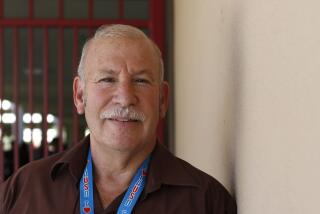Singled-out L.A. Unified teacher shares skills with colleagues
In February, fifth-grade teacher Miguel Aguilar stood in the front of a class, nervous and sweating.
The subject — reading and comprehension — was nothing new. But on this day, his students weren’t 11-year-olds in sneakers and sweatshirts: They were 30 of his fellow teachers.
It was the first time anyone at Broadous Elementary School in Pacoima could remember a teacher there being singled out for his skill and called upon to share his secrets school-wide.
“A teacher coming forward … that hadn’t happened before,” said Janelle Sawelenko, another fifth-grade teacher.
Months before, Aguilar had been featured in a Times article as one of the most effective teachers in the Los Angeles Unified School District at raising student scores on standardized tests. Many of his students, the article noted, had vaulted from the bottom 30% in the district to well above average.
More scores coming soon: The Times is preparing to release to the public a new round of value-added scores for Los Angeles elementary school teachers. Beginning Wednesday, all teachers who have a ranking in the updated database -- about 11,500 third- through fifth-grade teachers in all -- are invited to request a preview and comment on their scores at latimes.com/teacherresponse. To ensure that comments are included when the scores are published, please respond by April 14.
The article contrasted Aguilar’s performance with that of the teacher next door, John Smith, who ranked among the district’s least effective teachers. Pupils in both classes faced similar challenges in the poor, predominantly Latino community.
When the article appeared — followed soon after by a database ranking about 6,000 Los Angeles elementary school teachers — it ignited debate nationwide. Educators, teachers unions and experts warned that publicly rating teachers would pit one against the other.
Seven months later, Broadous teachers and the principal say the opposite has occurred. They’ve noticed a new openness to talking about what works, an urgent desire to improve. “It’s encouraged them to collaborate,” said Eidy Hemmati, the school’s intervention coordinator.
Indeed, Broadous teachers — including Smith — have repeatedly sought out Aguilar’s help this school year, despite the potential for hard feelings.
The new experiment, however, may be short-lived.
After a particularly long day of teaching several weeks ago, Aguilar found a pink slip in his mailbox. He was one of about 5,000 district teachers notified that they might lose their jobs this summer, depending on the troubled budget.
Smith didn’t get a pink slip. In California and most other states, seniority, not performance, is the sole consideration when layoffs come.
Smith has been with the district 15 years, Aguilar eight.
‘A lot of jealousy’
In the initial weeks after the article came out, Aguilar said he “went through hell.”
“There’s a lot of jealousy and hate out there.... People said things like, ‘There’s this guy who thinks he’s all good just because he’s Latino and he’s friends with the kids. How do you know he’s not cheating?’”
Many educators, including many at Broadous, were skeptical of The Times’ statistical approach, known as “value-added analysis.” In essence, it estimates a teacher’s effectiveness by measuring each student’s performance on standardized tests compared to previous years. Because it measures students against their own track records, it largely controls for socioeconomic differences.
Districts across the country are adopting the approach, but opposition to value-added remains strong among many teachers and their unions, and some experts consider it too unreliable for high-stakes decisions. Proponents acknowledge that it is imperfect, but say that it is the most reliable tool available and that it should be used along with other measures.
Like most districts, L.A. Unified historically hasn’t distinguished between its stars and its stragglers, often rating the vast majority of teachers “satisfactory.” And the culture of the teachers union values solidarity — during a protest against The Times last year, one of the union’s speakers shouted, “We are all John Smiths.”
By singling out Aguilar, the Times article had put him under an uneasy spotlight.
“Little by little I felt like I had to prove I was respected not just because of my test scores,” he said, “but because of what I’m teaching in my classroom.”
On visits to his classroom, Principal Stannis Steinbeck quickly concluded that Aguilar was not simply “teaching to the test” — a concern among critics of the value-added approach. He had an uncanny ability to connect with his students while commanding their respect.
When she learned later that Aguilar had devised his own method for teaching reading and comprehension, she asked for a demonstration. Steinbeck was impressed: Aguilar forced students to slow down and think before answering questions. Without dumbing down lessons, he broke down key concepts in a way that his fifth-graders, among the grade’s least fluent in English, could readily understand.
Steinbeck asked Aguilar if he’d be willing to lead a school-wide training session. Aguilar said her request “blew my mind.”
The demonstration to a classroom full of teachers in February was well received. So he went grade by grade giving sample lessons as the teachers looked on. Within six weeks, third-grade proficiency in reading and comprehension rose from 20% to 30%, Steinbeck said.
“Miguel is part of creating the new culture at this school,” Steinbeck said. “I think every principal should know that within their ranks there are teachers who can take the lead like this.”
Today, all Broadous teachers in second through fifth grades use his approach for reading and comprehension, Steinbeck said. Instructors have also begun using the method in history, social studies and science.
“We’re seeing the results in everything the kids are doing, including their essay writing,” Steinbeck said.
Aguilar’s fellow teachers expressed cautious enthusiasm. “His strategies are not the end all, they’re not the light from heaven,” said Sawelenko, the fellow fifth-grade teacher. “But it’s a step forward, and it’s a lot better than what we were doing.”
Critical thinking
“It’s time to begin workshop,” Aguilar told his class on a recent Friday morning.
The week before, the class had read a short story. Now, during the period each day when teachers can choose a skill to reinforce, the students were going to tackle some comprehension questions they had composed.
“It’s going to get us to think,” he told the class, “to become better critical thinkers.”
“Follow with your finger as we read aloud,” he said. In unison, the class read, “Why was Robert afraid of catching the ball?”
At this point in many classrooms, students would work independently or in groups to answer the question. But Aguilar had his students take out crayons and colored pencils to dissect the question and circle the main point.
Most circled the words, “Why was Robert afraid.”
Aguilar called, unsolicited, on different students, checking their comprehension before asking the others whether they agreed. He then asked the class what the question was asking for, a prediction or an inference.
Once the class had settled on inference, the students went back to the story to find evidence to support their answer.
After 30 minutes working through the questions, each student wrote down his or her answer. The process eventually becomes automatic for students and they cover the material more quickly, Aguilar said.
That night at home, Aguilar made a chart of which students got which type of questions wrong. The next week, he would put them in groups to focus on that particular comprehension skill.
It wasn’t rocket science, he admitted. But it worked.
Working together
After his February demonstration, Aguilar said, Smith approached him. “He said he really found it helpful, and he was going to try to implement it in his room,” Aguilar recalled.
Since then, the two have been working closely together, most recently to help Smith catch up in math, where his class had slipped several chapters behind, Aguilar said.
Steinbeck has worked with Smith too, team-teaching with him often this year. “He’s grateful for the help,” she said. “He says he’s learning a lot this year and feels comfortable.”
“I’m not saying he’s perfect yet … but we’ve been working together more closely, and he truly understands what he needs to do.”
Smith would not comment for this article. District officials did not respond to a request for comment.
Steinbeck and several teachers at the school said they feared the new spirit of collaboration would dissolve if Aguilar were laid off this summer.
“Honestly, if he leaves, I won’t have anyone to collaborate with,” Sawelenko said. “It’s an absolute disservice to children and it’s morally wrong.”
More to Read
Start your day right
Sign up for Essential California for news, features and recommendations from the L.A. Times and beyond in your inbox six days a week.
You may occasionally receive promotional content from the Los Angeles Times.






